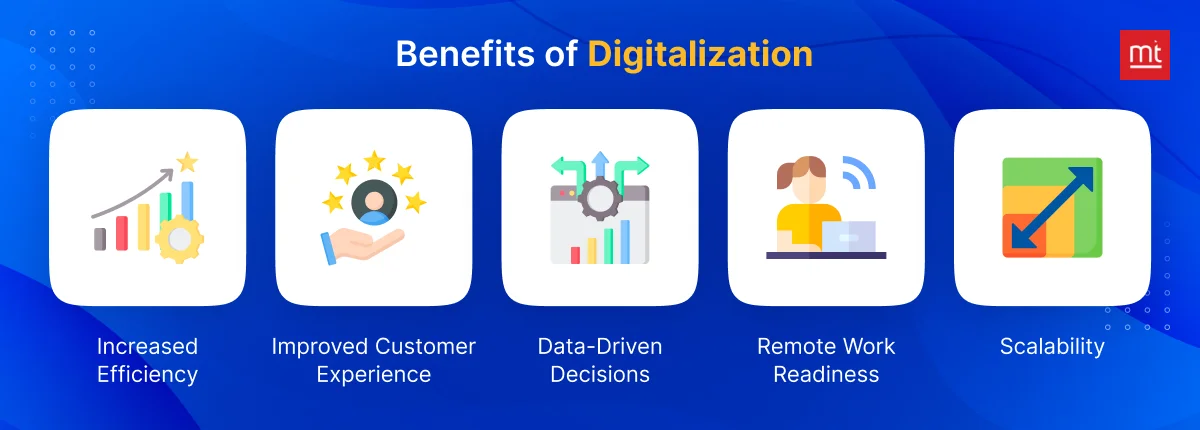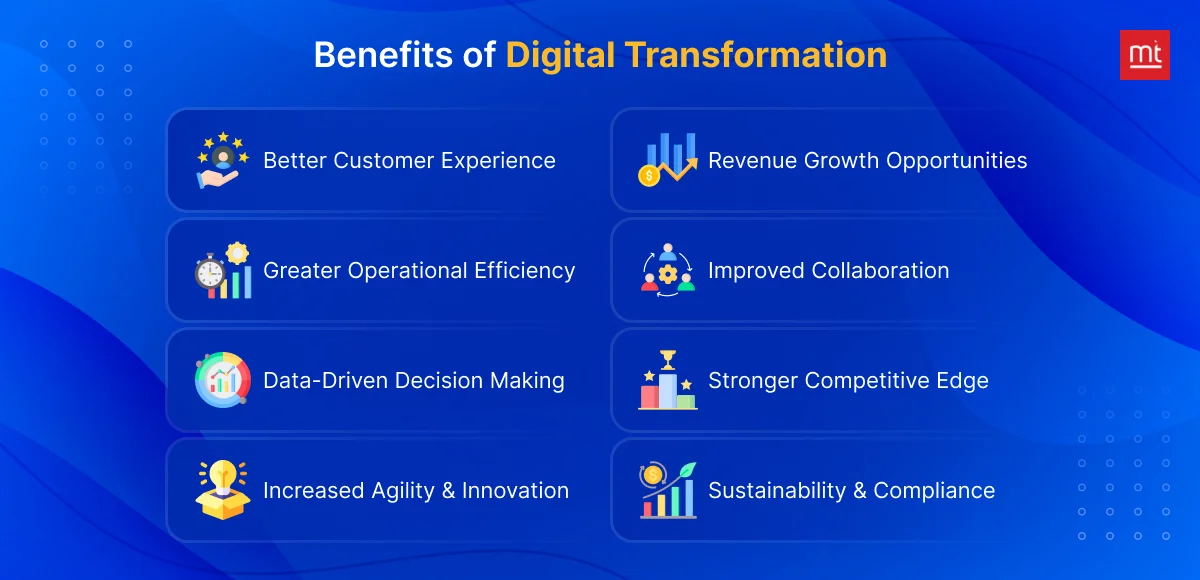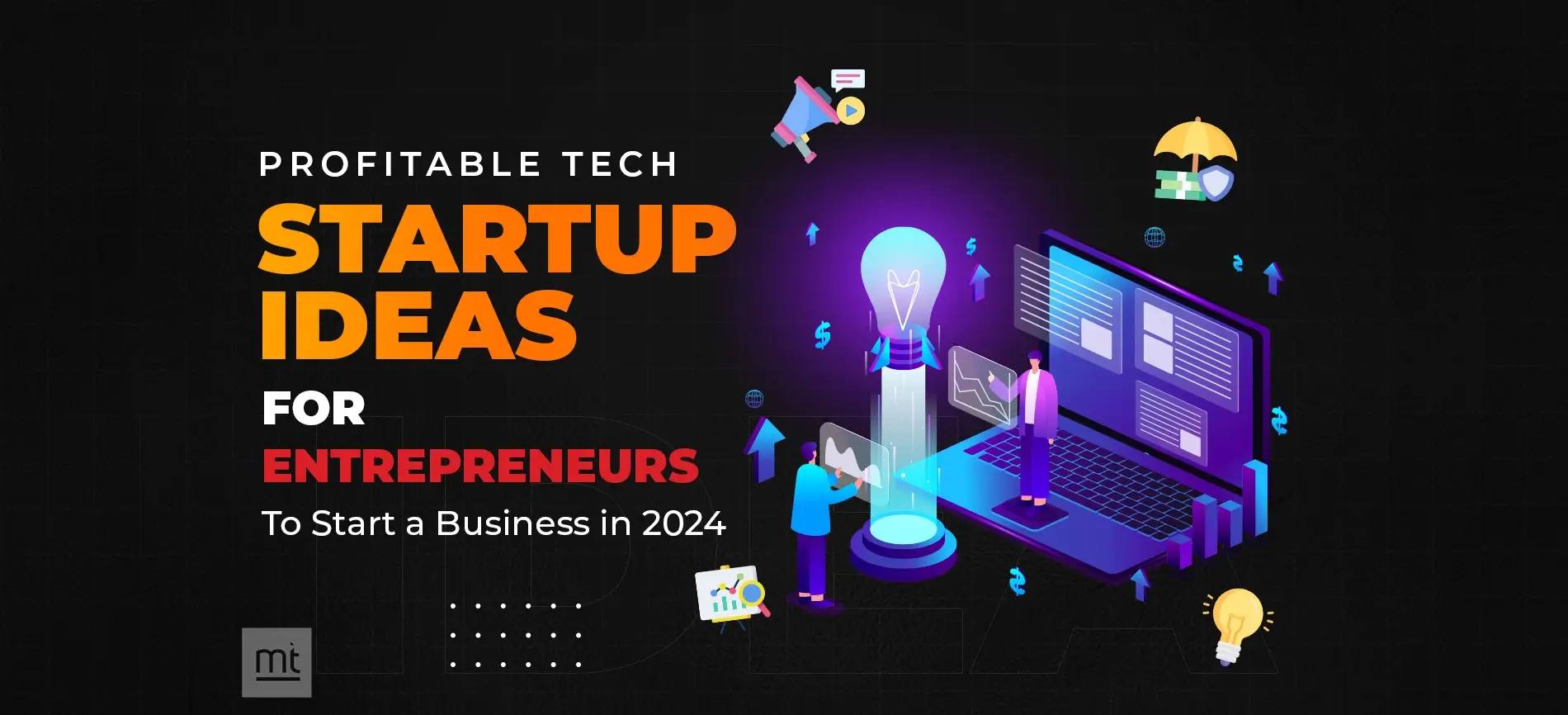Key Takeaways:
After reading this article on Digitization vs Digitalization vs Digital Transformation, you’ll find answers to crucial questions like:
- What is the difference between digitization, digitalization, and digital transformation?
- Which one does my business need right now, digitization, digitalization, or digital transformation?
- How do I know if my business is ready for digital transformation?
- How can I find the right partner or team for my digital journey?
Introduction:
Do you know that 74% of businesses give digital transformation as a top priority? Forbes research finds 89% have already started implementing a digital-first strategy in their business. The digital transformation market is expected to reach $3375 billion by 2032. This clearly shows the future is digital. To get the most out of the digital transformation, it's crucial to be clear with certain terms related to the digital world. You might have heard of digitization, digitalization, and digital transformation, but still many of us misunderstand and confuse these terms because they sound similar.
Many business owners don't have clarity on digitization vs digital transformation or digital innovation vs digital transformation, but what really matters is knowing which one fits your current stage, and that’s exactly what this guide covers.
In this blog, you will learn the basic definition, benefits, to compare digitization vs digitalization vs digital transformation and implement it in the right way for your business.
What is Digitization?
Digitization is the process of converting any physical or analog information into a digital form. For example, scanning paper documents to store them on a computer or moving from manual records to digital files.
What Are the Key Benefits of Digitization?
Digitization makes information easier to access, reduces storage costs, improves data security, ensures better disaster recovery, and supports eco-friendly practices. Looking for more details? Here’s an in-depth look at the benefits of digitization.

1. Faster Access to Information
You can easily find the required document or info by searching for a suitable keyword. This saves a lot of time and helps in quick decision-making.
2. Less Storage Cost
No need to store the data in cabinets, shelves, or warehouses. Digital files can be stored on a server or cloud platforms.
3. Enhanced Data Security
Physical documents have a chance of getting stolen or lost. In case of digital information, you can protect it with encryption, passwords, and user permissions.
4. Disaster Recovery
In case of disasters like fire, flood, or hardware failure, digital data is easier to recover because of regular backups and cloud storage.
5. Environmental Benefits
Digitization is eco-friendly. It reduces the use of paper, ink, and other physical resources. Hence, ultimately, you are creating less waste and carbon footprint.
What is Digitalization?
Digitalization is about improving how a business operates, serves customers, and creates value. It’s not just about converting physical things into digital. It’s about changing the way of doing business by using technology.
What Are the Key Benefits of Digitalization?
Digitalization empowers businesses with automation for higher efficiency, enhances customer experiences, enables data-driven decisions, supports remote operations, and ensures scalable growth. Want to know more? Here are the key benefits explained.

1. Increased Efficiency
Digitalization helps streamline workflows by automating repetitive tasks and reducing manual work. For example, you can automate billing, online approvals, or digital inventory systems.
2. Improved Customer Experience
By using digital tools like chatbots, mobile apps, or personalized email marketing, you can connect with customers faster by responding to their queries, offer self-service options, and customize the service as per individual preferences.
3. Data-Driven Decisions
By using data insights, you can understand customer behavior, market trends, and performance metrics better. Instead of guessing, you make decisions based on facts.
4. Remote Work Readiness
Employees can also work remotely by using digital tools like cloud storage, video conferencing, and online collaboration platforms, and coordinate from anywhere.
5. Scalability
Digital systems are easily expandable with growing customers and manage the business growth over time. That too with minimal disruption.
What is Digital Transformation?
Digital transformation is the process of using digital technologies to change how a business operates, delivers value to customers, and stays competitive. It’s about rethinking your strategy, improving customer experiences, and building a smarter, more flexible business.
What Are the Key Benefits of Digital Transformation?
The benefits of digital transformation include enhanced customer experience, streamlined operations, data-driven decision-making, increased innovation, new revenue opportunities, and improved team collaboration. Interested in knowing more? Discover the detailed benefits here.

1. Better Customer Experience
You can create a better experience for customers through mobile apps, chat support, and customized recommendations.
2. Greater Operational Efficiency
Digital transformation can simplify workflows, reduce delays, and help teams to focus on high-value work instead of repetitive tasks. The repetitive tasks can be automated like managing inventory, approvals, etc.
3. Data-Driven Decision
You can collect useful user data via digital tools to understand what's working, what customers want, and where to improve.
4. Increased Agility & Innovation
With the right tools and mindset, teams can experiment, test ideas quickly, and bring new products or services to life.
5. Revenue Growth Opportunities
When your business runs efficiently, serves customers better, and adapts faster, you open the door to new revenue streams. Digital tools help you reach more people, offer new services, and create better value.
6. Improved Collaboration
Teams can easily share ideas, and work together, no matter where they are. Tools like project management software, cloud storage, and video meetings help keep everyone connected.
Digitization vs Digitalization vs Digital Transformation: Key Differences at a Glance
Look at the table below to get more clarity on digitization vs digitalization vs digital transformation.
Aspects | Digitization | Digitalization | Digital Transformation |
Purpose | To convert physical information into digital form. | Use digital tools to improve everyday business processes. | Use digital technologies to improve business style. |
Business impact | Improves data storage and access. | Increases process speed, accuracy, and efficiency. | Creates new value, better customer experiences, and long-term business growth. |
Scope | Focuses on documents or data only. | Focuses on functions like sales, HR, or operations. | It has wider impacts on strategy, culture, and customer engagement. |
Cost | Low- usually a one-time investment | Medium- you need training to use the tools. | Costly as it needs to invest in technologies, and hiring specific professionals. |
Implementation time | It can usually be completed within days or weeks | It might take a few weeks or months according to its complexity. | It can take months or years as it transforms the way of working. |
Example | Scanning paper documents into PDFs. | Using CRM for sales tracking and automating payroll. | Using an AI-powered platform for businesses to move their business online. |
People involvement | IT or admin staff are involved. | Teams are involved in improving their work with digital tools. | Here, company leaders are involved as it is about bringing big change. |
Tools used | Scanners, file converters, and basic databases. | CRM systems, cloud software, and automation tools. | AI, cloud platforms, IoT, big data, digital strategies. |
What do they have in common?
So, from the above table, you might have clarity about how digitization, digitalization, and digital transformation are different. But they also have some similarities.
All three use technology to improve how a business works. Here’s how they are similar.
- Technology at the Core: All three depend on digital tools, software, or systems to make work easier, faster, and more organized.
- Better Efficiency: All three focus on improving the efficiency of the business.
- Improved Access to Information: All three make it easier to find, share, and use information.
- A Step Toward Growth: All three are part of the same journey. Digitization is usually the first step, then comes digitalization, and then full digital transformation. When you use all three one by one, it helps businesses grow and adapt to the digital age.
The Hidden Risks of Going Digital: What Every Business Should Know
Going digital has lots of benefits, but as every good thing comes with some cons. Moving digital also has some risks that you must know to protect your business and use digitalization smartly.

1. Cybersecurity Threats
As digital tools need the internet to use. They are at risk for vulnerabilities and data breaches if security measures like encryption, firewalls, and access controls are not followed. Have a separate database storage for sensitive information, and make sure you give access only to trusted users.
2. Integration Issues
Incompatible software or outdated infrastructure can cause delays, data inconsistencies, or functionality gaps while integrating digital tools in your current system. Do proper planning and have professional IT support to smoothly integrate digital tools and deal with issues if they arise.
3. Unexpected Costs
Digital tools are beneficial in reducing costs and improving efficiency. You may need to train staff to use it properly. Also, there can be hidden software fees, upgrades in the future, support services, and many other things with the changing digital trends.
4. Lack of Digital Skills
If the employees are not skilled enough to use digital tools, this can lead to slower adoption and lead to errors while using them. This will eventually slow down the positive results of the business.
5. Downtime and Disruption
When you integrate or implement digital tools or systems for the first time, it can cause temporary downtime to settle things and sync properly. Downtime during setup, updates, or migrations can affect operations and customer experience.
6. Over-automation
Automating too many tasks for business may give relief, but some processes need human judgment, and replacing them with automated tools can reduce the quality of the work. It is important that you use automation where needed and maintain a balance of humans of automation.
7. Vendor Lock-In
If you depend on a single vendor, it can affect your business suddenly when they change their pricing, limit features, or support service.
When to Choose What: Use Cases for Business Owners
Choose Digitization If:
- You're using paper-based records and want to move to digital.
- You need faster access to documents and easy file storage.
- I want to reduce physical space and manual handling.
- You have a limited budget.
- You are a small business looking to start a digital journey.
Choose Digitalization If:
- You are a medium-sized business and want to work smart.
- You already have some digital data, like spreadsheets, files.
- You want to automate routine tasks such as billing, inventory, HR, etc.
- You want to improve speed and accuracy in operations.
- You want good collaboration and productivity tools (CRM, cloud apps).
Choose Digital Transformation If:
- You are expanding your business.
- Your business needs advanced tech stacks like AI, IoT, or advanced analytics.
- You want to give competition in a fast-changing digital market.
- You are highly focused on innovation and long-term impact.
How to Choose Between Digitization, Digitalization, and Digital Transformation?
Every business is at a different stage in its digital journey. You can only achieve the best results of these three when you use them at the right time. Consider these points to analyze your needs and make a decision.
1. Assess your business’s current digital maturity
Start by checking how digital your business is today. Are you still using paper-based records? Are some processes already digital but not connected? Understanding your current state helps you figure out where you are on the digital journey and whether you just need small fixes or a full transformation.
2. Identify gaps in tools, data, and processes
Look for areas where your tools, systems, or workflows are outdated or manual. Are teams wasting time on repetitive tasks? Is data hard to find or use? These questions will show whether digitization or automation can solve the problem.
3. Choose whether you need digitization, digitalization, or transformation
Now you know the current state and gaps, decide what level of change you need. If you just need to go paperless, start with digitization. If you want to speed up processes, choose digitalization. If you need to refine how your whole business runs, go for digital transformation.
4. Set goals and KPIs
Define clear goals—like reducing paperwork by 80%, cutting processing time, or improving customer satisfaction. Set KPIs to measure progress. This will help you to know whether your digital approach is really working as you expected.
5. Build or partner with the right tech team
You’ll need the right people to make your digital journey successful. You can either outsource your requirements or hire a mobile app development company, like ManekTech, to support you from planning to launch.
How can Manektech help you with Digital Transformation?
Manektech has been the choice of top businesses as the top IT outsourcing company due to proven records of successful digital transformation. We have industry-trained experts of 450-plus teams who specialize in using the latest technologies like AI, ML, cloud, blockchain, and more to fulfill digital standards of diverse business requirements.
Whether you want to modernize your outdated system, enhance operation, or need help with digital strategy, hire dedicated developers from us to get the best digital solution for your business growth.
Final Thoughts
Hope this blog helps you to understand Digitization vs Digitalization and how it differs from digital transformation. Digitization and digitalization come under digital transformation. Digitization is a process, and digitalization is a strategy, while digital transformation is a complete transformation of a business to bring new changes. You must plan your digital strategies by looking at your past, present phase, and future goals.
Book a consultation call with our digital transformation expert to get a free digital audit.
FAQ Related to Digitization and Digitalization and Digital Transformation
Q 1: Why Are Digitization and Digitalization Important for Business Growth?
Ans: The process of digitizing and digitalizing helps businesses become faster, organized, and more efficient in terms of cost. By converting paper into digital files, and by relying on a few choice tools to handle more tasks automatically, companies can save time, reduce errors and become better decision makers. This allows teams to get back to what they should be doing - growing, innovating, & servicing the customer. These are building blocks for growing and competing in today’s digital-first environment.
Q 2: Is Digital Transformation Just the Automation of Business Processes?
Ans: No, there’s so much more to digital transformation than automation. Automation is part of the story, but transformation is about reimagining your whole business model, your customer experience, and your operations with digital technology. It’s about being flexible, data-driven, and future-ready — not just speeding up routines, but changing the way you deliver value.
Q 3: How Do I Know If My Business Is Ready for Digital Transformation?
Ans: If your existing systems are outdated, your team is facing inefficiency, or your customers expect more digital options, then your business needs a digital transformation. And if you have clear business goals that are related to new technologies, leadership support, and openness to change, it’s a good indicator that you’re ready.
Q 4: Can I Skip Digitization and Jump Straight to Digital Transformation?
Ans: It can be, but not always in practical ways. Digitization is the first step before digital transformation to move from paper-based to digital-based before automating or rethinking processes. Skipping it could result in the database missing parts of the data.
But if your business is already digital, you can easily transform it digitally.
Q 5: How Much Does Digital Transformation Cost, and How Long Does It Take?
Ans: Recent research says that the cost of digital transformation for big enterprises can go up to $27.5 million. If your business needs medium digital transformation, you can expect costs between $50,000 to $500,000.
Get your business analyzed by a reliable IT outsourcing company to get a personalized quote.
Subscribe to Our Newsletter!
Join us to stay updated with our latest blog updates, marketing tips, service tips, trends, news and announcements!























